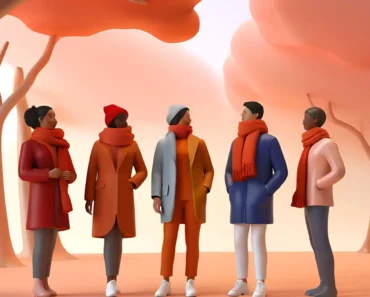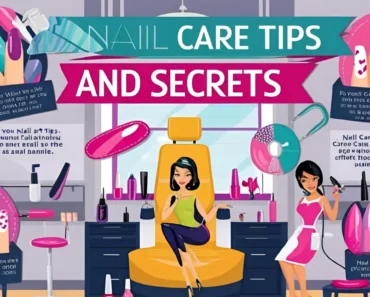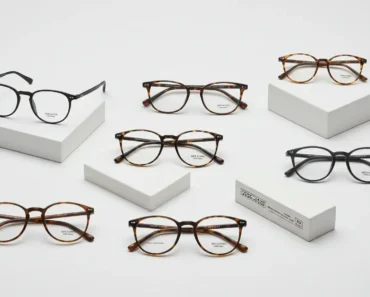Top 20 Custom Engagement Rings – Unique Designs for Your Perfect Proposal. This guide explores the unparalleled beauty and personal significance of custom-designed engagement rings, offering inspiring ideas and practical advice to create a truly one-of-a-kind symbol of love.
The Heart of Your Story: Why Custom Engagement Rings Matter
An engagement ring is more than just a piece of jewelry; it is a profound symbol of love, commitment, and a unique shared journey. While many beautiful ready-made rings exist, the desire for something truly distinctive often leads couples to explore Custom Engagement Rings. This personalized approach ensures the ring reflects the unique story, personality, and style of the wearer, making the proposal even more meaningful.
Opting for Custom Engagement Rings moves beyond mass-produced designs. It allows you to infuse every detail with intention. You select the perfect gemstone, choose a metal that speaks to your aesthetic, and design a setting that captures your vision. This creative process itself becomes part of the love story, building anticipation and personal connection to the final piece. It transforms a transaction into a collaborative work of art.
Investing in Custom Engagement Rings ensures a one-of-a-kind symbol that no one else will have. It represents thoughtful consideration and a deep understanding of your partner’s individuality. This personal touch elevates the proposal moment, making it unforgettable. It creates a cherished heirloom that will carry emotional significance for generations.
Key Factors in Designing Custom Engagement Rings
Creating Custom Engagement Rings involves several crucial decisions. Each choice contributes to the ring’s overall aesthetic, durability, and personal significance. Understanding these factors guides your design process.
Gemstone Selection: Beyond the Diamond

While diamonds remain a classic choice, Custom Engagement Rings open the door to a world of alternative gemstones. Consider sapphires (known for durability and color variety), emeralds, rubies, moissanite, or lab-grown diamonds. Each stone offers unique color, brilliance, and symbolic meaning.
Factors to consider:
Hardness: Important for daily wear (diamonds are hardest).
Color: Choose based on personal preference and meaning.
Cut: Influences sparkle and shape (round, oval, pear, emerald).
Ethical sourcing: Increasingly important for conscious consumers.
The gemstone is often the centerpiece. Its selection heavily influences the ring’s character.
Metal Choice: The Foundation of Your Design
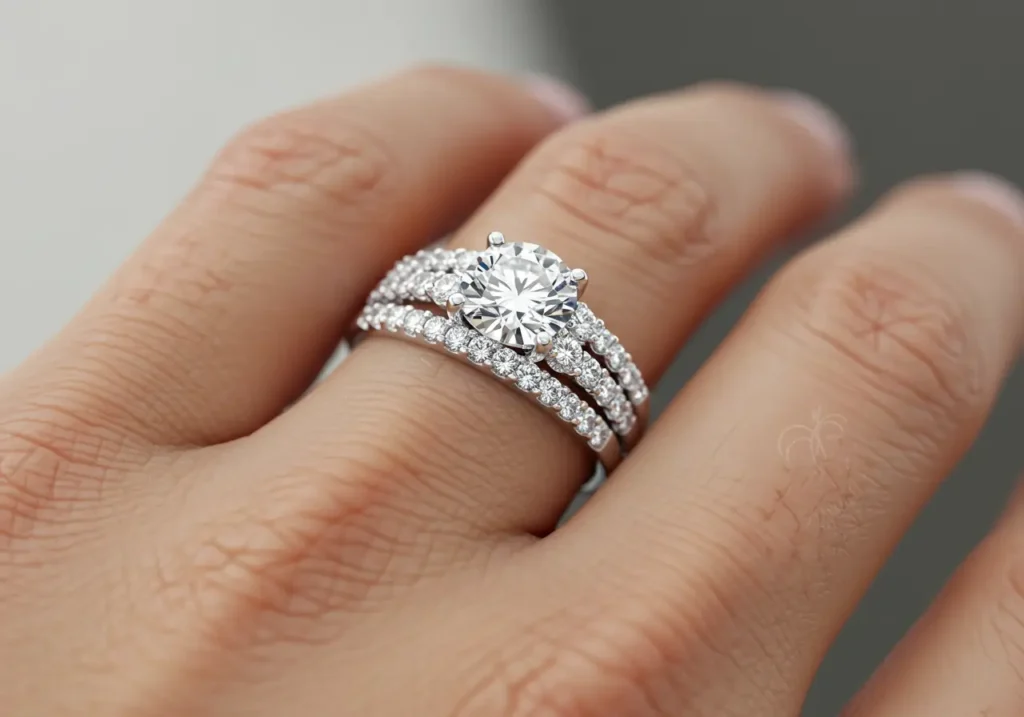
The metal sets the tone for the entire ring and impacts its durability and appearance.
Platinum: Extremely durable, naturally white, hypoallergenic.
White Gold: Popular, but requires rhodium plating every few years to maintain its bright white color.
Yellow Gold: Classic, warm, and timeless. Available in 10k, 14k, 18k (higher karat means softer).
Rose Gold: Romantic and modern, with a pinkish hue.
Consider your partner’s skin tone, lifestyle, and existing jewelry collection when choosing the metal. The metal choice for Custom Engagement Rings significantly influences longevity.
Setting Style: Highlighting the Gemstone
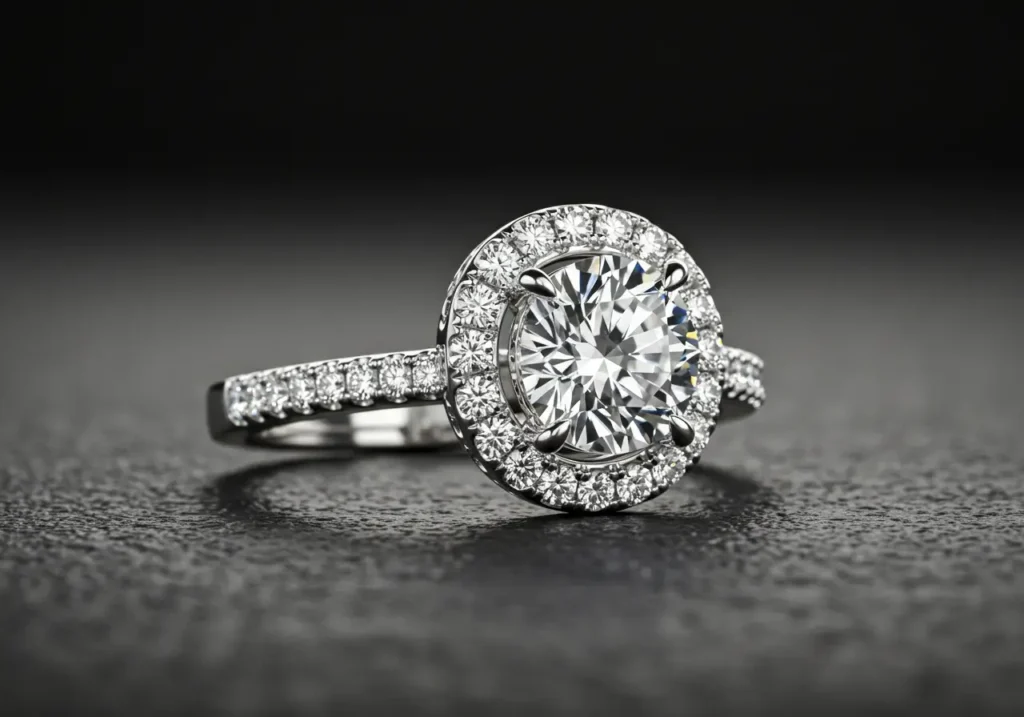
The setting holds the gemstone in place and contributes significantly to the ring’s overall look.
Prong Setting: Most common, maximizes light entry to the stone.
Bezel Setting: Encircles the stone completely, offering maximum protection.
Pavé Setting: Features tiny diamonds set closely together, creating a pave-like surface.
Halo Setting: A ring of smaller diamonds surrounds the center stone, enhancing its perceived size and brilliance.
Tension Setting: Holds the stone in place using metal tension, giving a floating appearance.
Consider the gemstone’s security, desired brilliance, and maintenance.
Personalized Details: Infusing Meaning

Custom Engagement Rings allow for unique personal touches that tell your story. This could include:
Engravings: Dates, initials, meaningful phrases.
Hidden details: A small birthstone on the inside of the band, a unique filigree design under the setting.
Unique side stones: Using specific colored diamonds or gemstones to represent birth months or shared memories.
Incorporating elements from a shared hobby, a significant place, or a personal symbol.
These details make the ring profoundly personal and truly one-of-a-kind.
Top 20 Custom Engagement Rings – Unique Designs for Your Perfect Proposal
These inspiring ideas showcase the vast possibilities when designing Custom Engagement Rings, offering concepts that blend classic elegance with personalized flair.
1. The Hidden Halo Solitaire
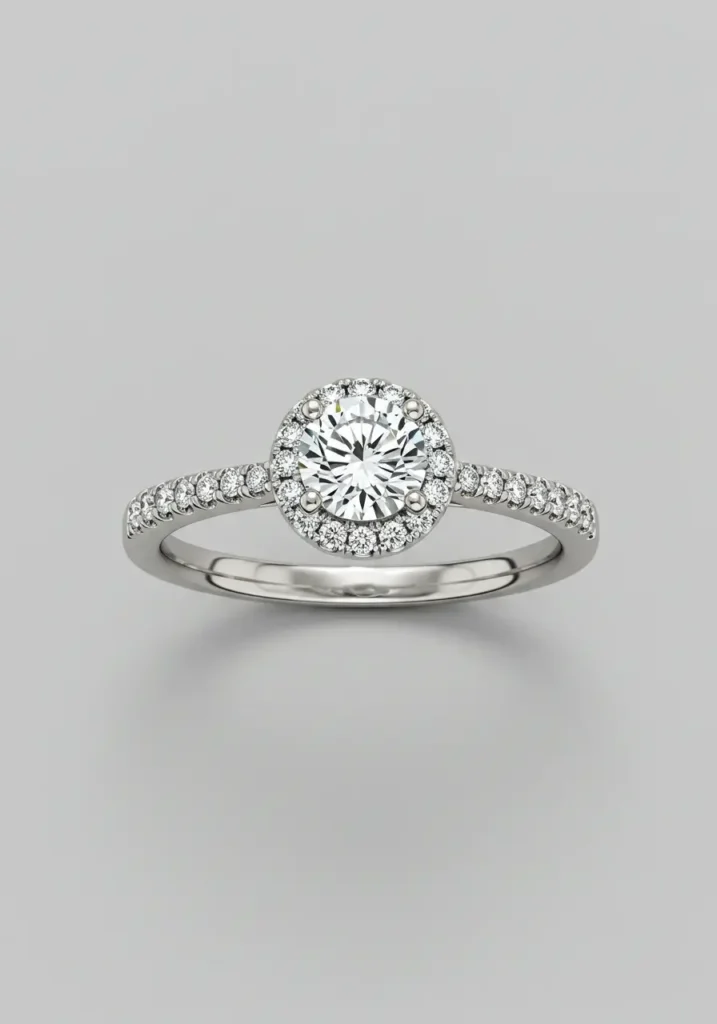
A classic solitaire setting with a discreet halo of tiny diamonds tucked just below the main stone. This adds sparkle and enhances the center stone’s brilliance without being overtly flashy, creating a subtle surprise.
2. Asymmetrical Three-Stone with Mixed Cuts
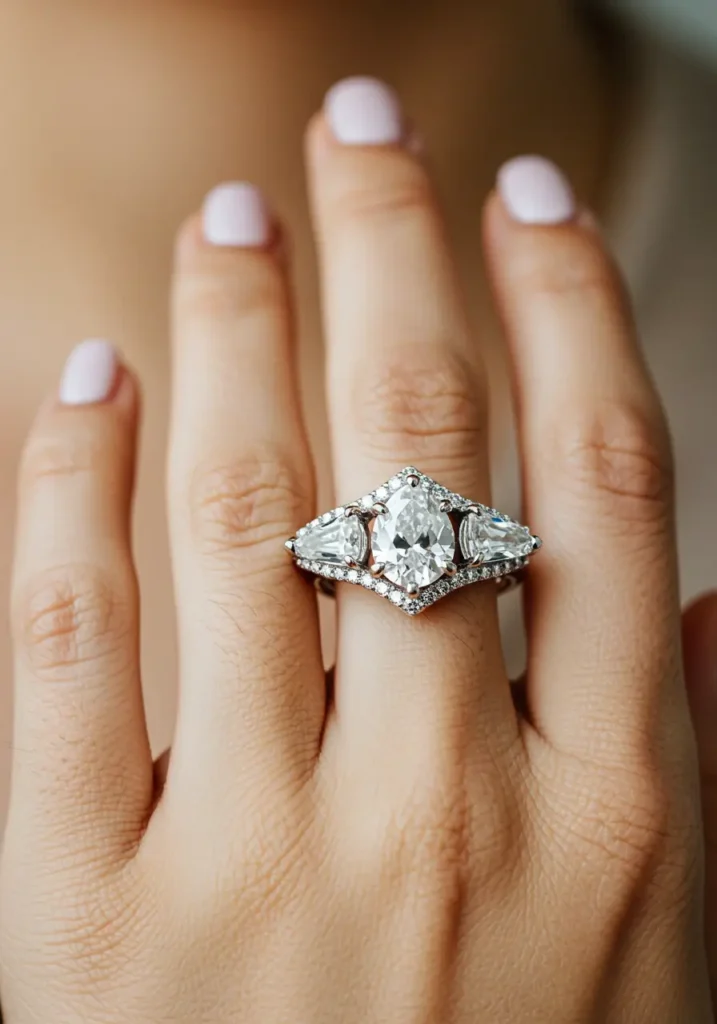
Instead of traditional three stones in a row, arrange them with an asymmetrical balance, using mixed gemstone cuts (e.g., a round center with a pear and an emerald cut on either side). This creates a modern, artistic look.
3. Vintage-Inspired Filigree with Milgrain Detailing
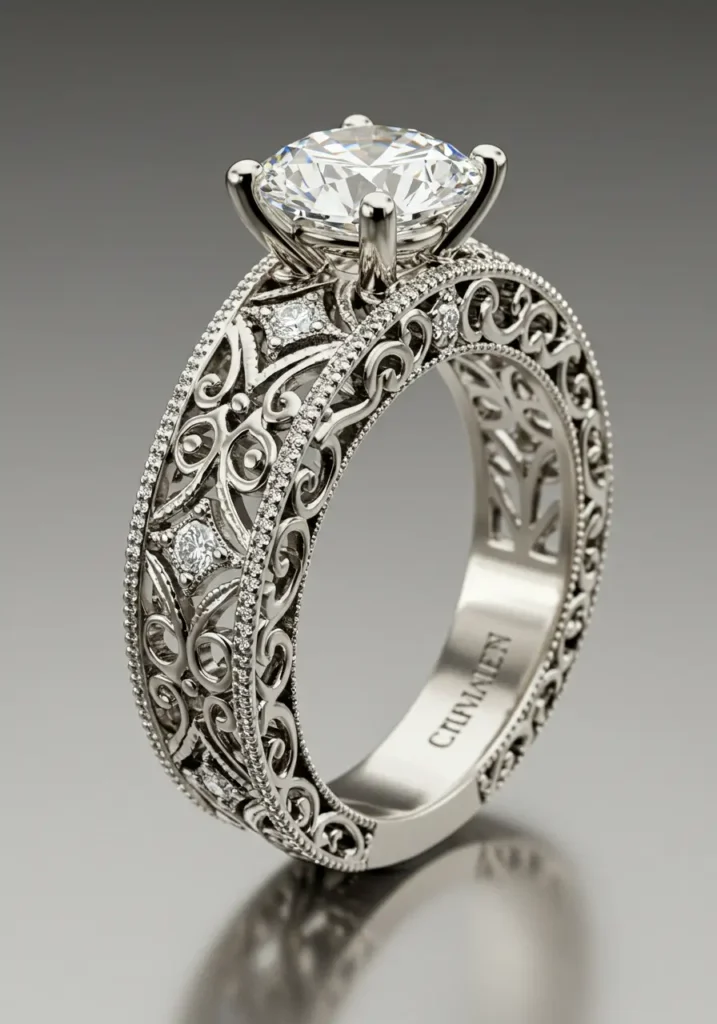
Design a ring with intricate filigree work (delicate metal scrollwork) and milgrain edging (tiny bead-like details along the edges). This evokes a romantic, antique feel, perfect for a timeless piece among Custom Engagement Rings.
4. The Bezel-Set Pear with a Diamond Band

A pear-shaped gemstone set securely in a bezel (metal rim) for modern protection. Pair it with a delicate diamond-paved band for added sparkle. This combines safety with elegance.
5. Art Deco-Inspired Geometric Design
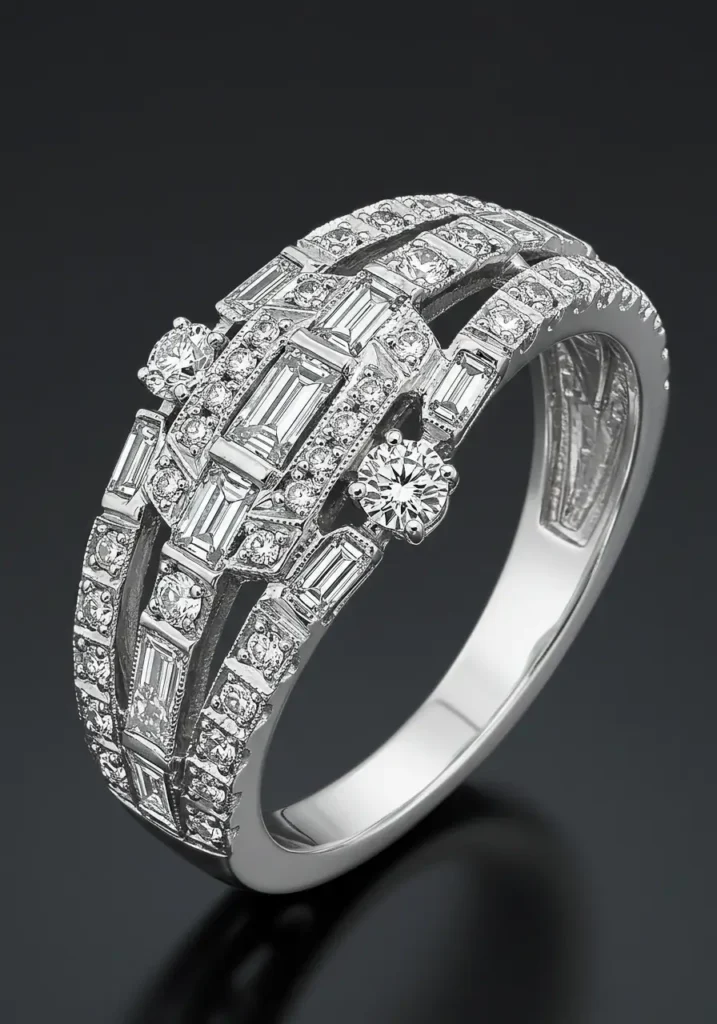
Draw inspiration from the Art Deco era with bold geometric patterns, symmetrical lines, and a mix of diamond cuts (e.g., baguette, emerald, round) within the setting. This creates a striking, architectural statement.
6. Nature-Inspired Vine or Leaf Band
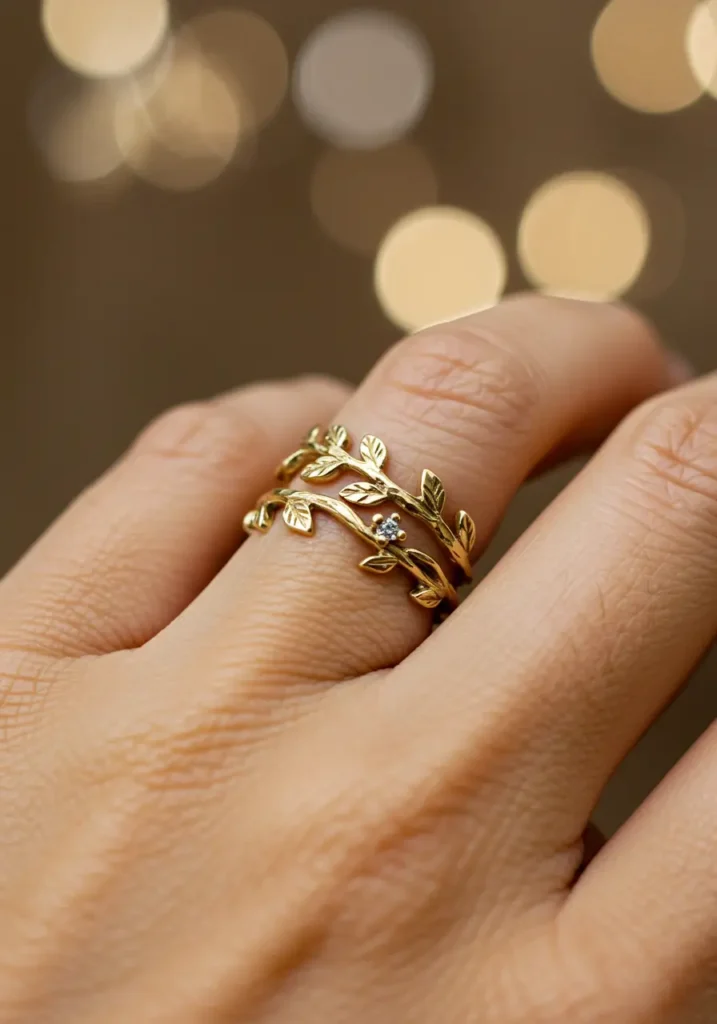
Incorporate organic elements into the band design, such as delicate vine motifs, intertwined leaves, or floral accents. This creates a natural, romantic, and unique look, symbolizing growth and connection.
7. The Toi et Moi Ring with Contrasting Gems
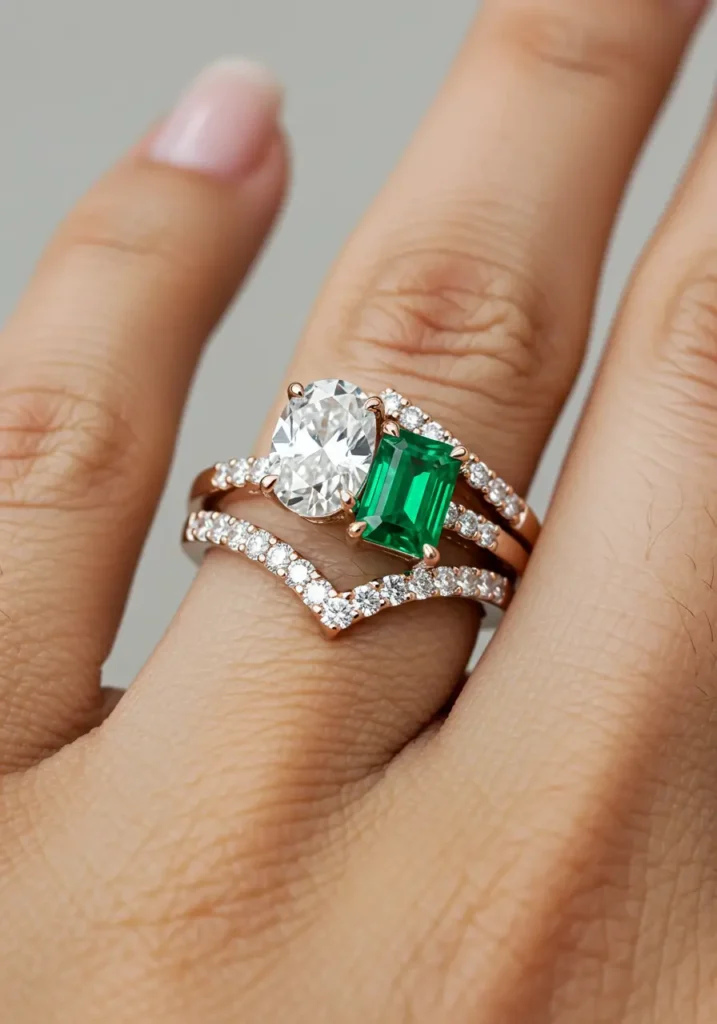
The “You and Me” ring features two main gemstones, symbolizing two souls uniting. Choose contrasting cuts (e.g., oval and emerald) or different colored gems for a unique, modern interpretation of this classic style. This represents a personal story in Custom Engagement Rings.
8. Emerald Cut with Trapezoid Side Stones
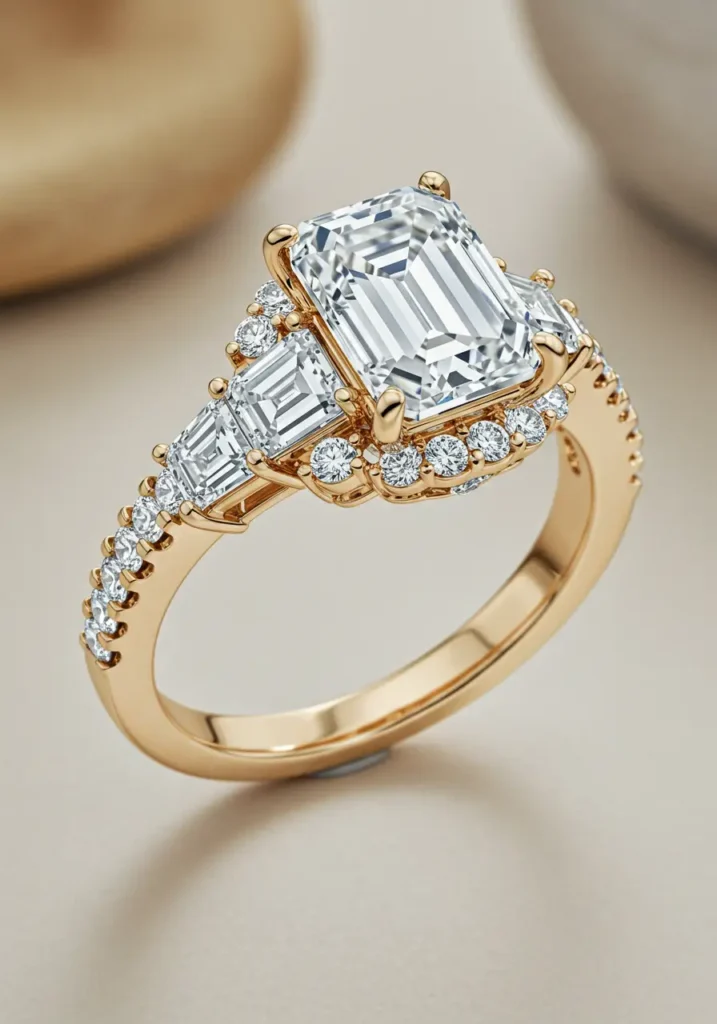
Highlight a sophisticated emerald-cut diamond or gemstone with trapezoid-shaped side stones. This creates an elegant, streamlined, and architectural look that maximizes the center stone’s clean lines.
9. The Unique East-West Oval Setting
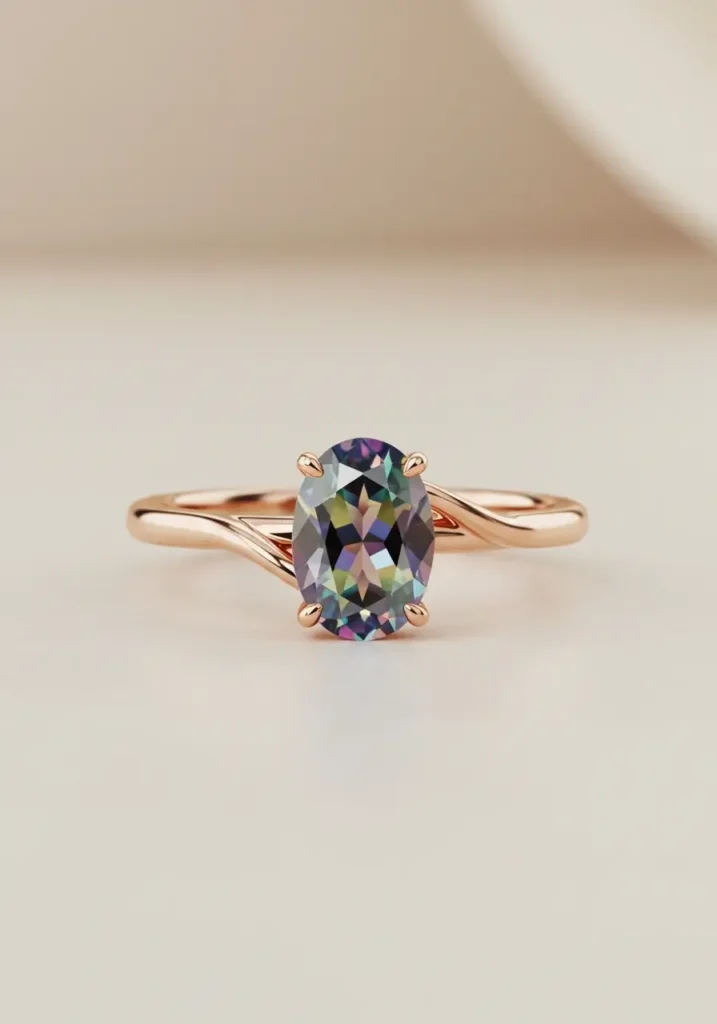
Instead of the traditional north-south orientation, set an oval-cut gemstone horizontally (east-west) on the band. This creates a modern, understated, and unique aesthetic that stands out subtly.
10. Raw Diamond or Unconventional Cut
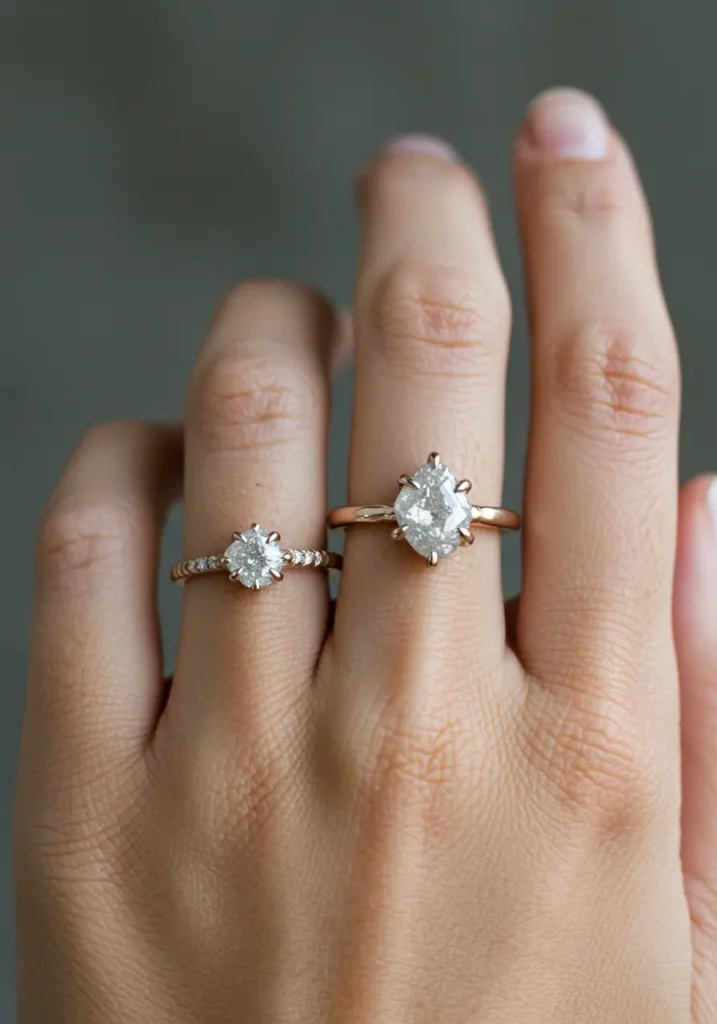
For a truly unique and bohemian feel, opt for a raw, uncut diamond or an unconventional, rough-hewn gemstone. This celebrates natural beauty and provides an organic, earthy aesthetic. This is a distinct choice for Custom Engagement Rings.
11. The Colorful Sapphire Center Stone with Diamond Accents
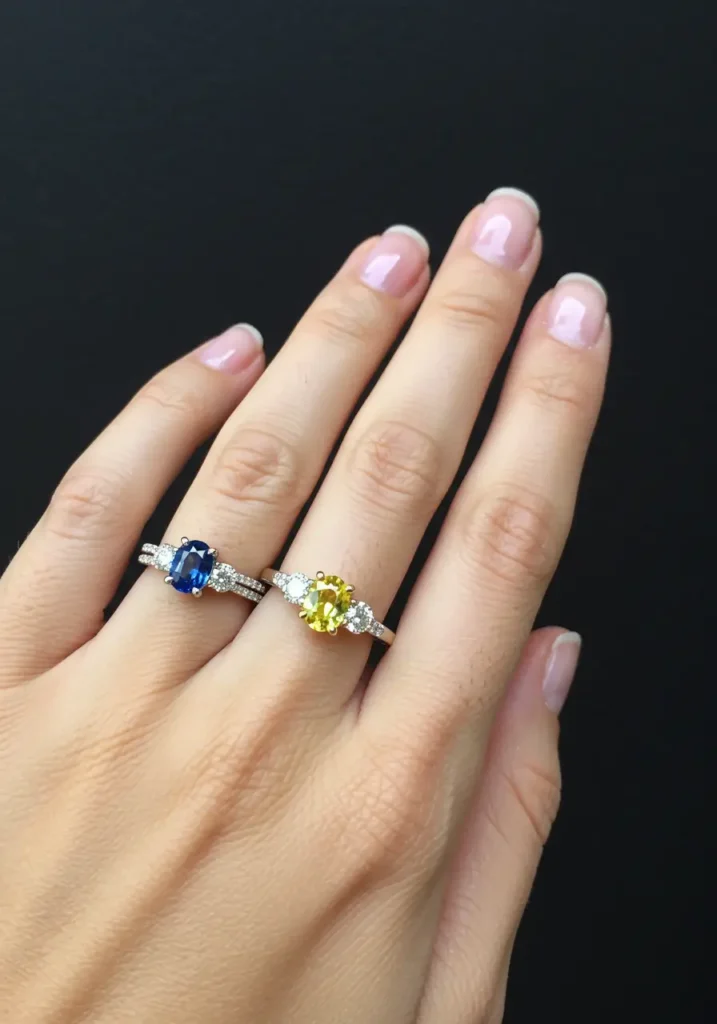
Move beyond white diamonds. Choose a vibrant sapphire (blue, pink, yellow, green) as the center stone, flanked by delicate diamond accents. This adds a pop of color and personality while maintaining classic elegance.
12. Split Shank with Pave Diamonds
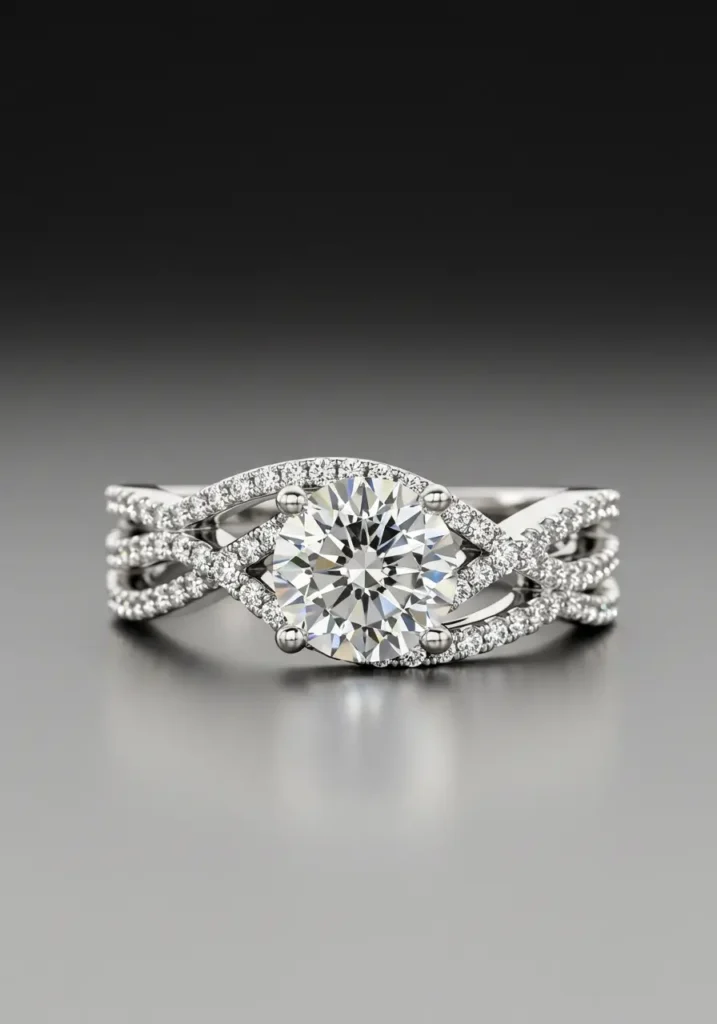
A split shank band divides into two or more strands as it approaches the center stone, often adorned with pavé-set diamonds. This creates a visually intricate and sparkling foundation, enhancing the main gem’s presence.
13. The Minimalist Tension Setting
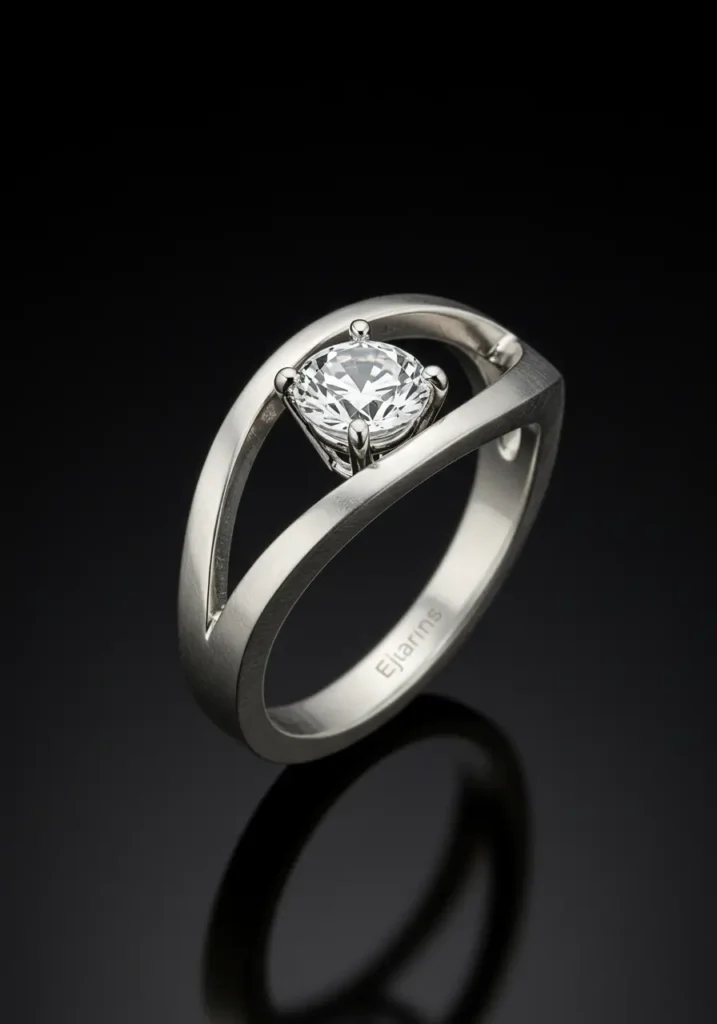
A contemporary setting where the gemstone appears to float between two pieces of metal, held only by tension. This creates a clean, modern, and striking look that emphasizes the stone’s purity.
14. Halo Setting with a Cushion Cut Gemstone
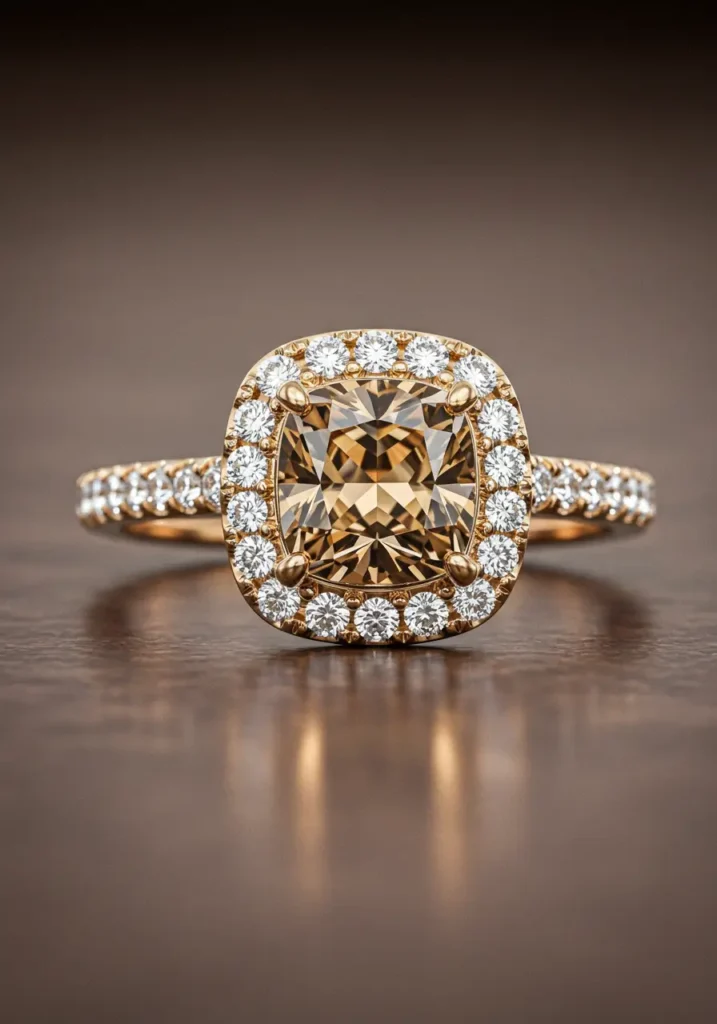
A cushion-cut gemstone (softened square shape) surrounded by a halo of smaller diamonds. This combination maximizes sparkle and creates a vintage-inspired yet timelessly romantic look.
15. Black Diamond or Unique Dark Gemstone
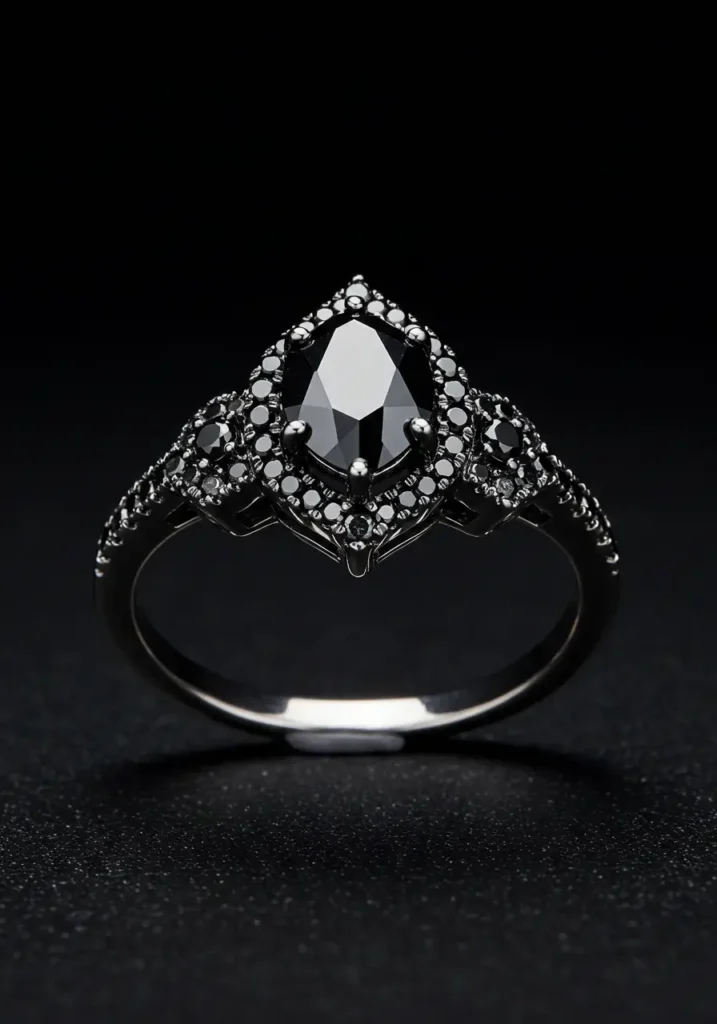
For a bold, unconventional statement, choose a black diamond as the center stone. Alternatively, consider other dark gemstones like black spinel or onyx. This creates a dramatic and edgy aesthetic, perfect for a distinctive personality.
16. Double Band with Mixed Metals
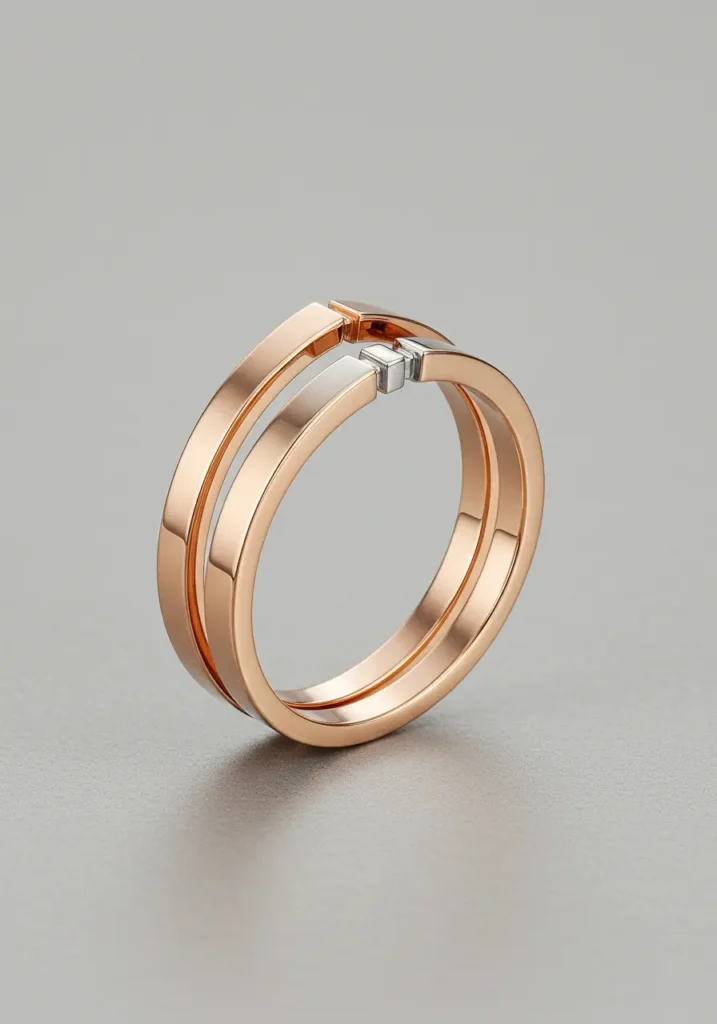
Design a ring with two separate bands that run parallel or intersect, possibly using mixed metals (e.g., rose gold and platinum). This creates a modern, architectural, and multi-dimensional look.
17. Engraved Sidestones or Hidden Message
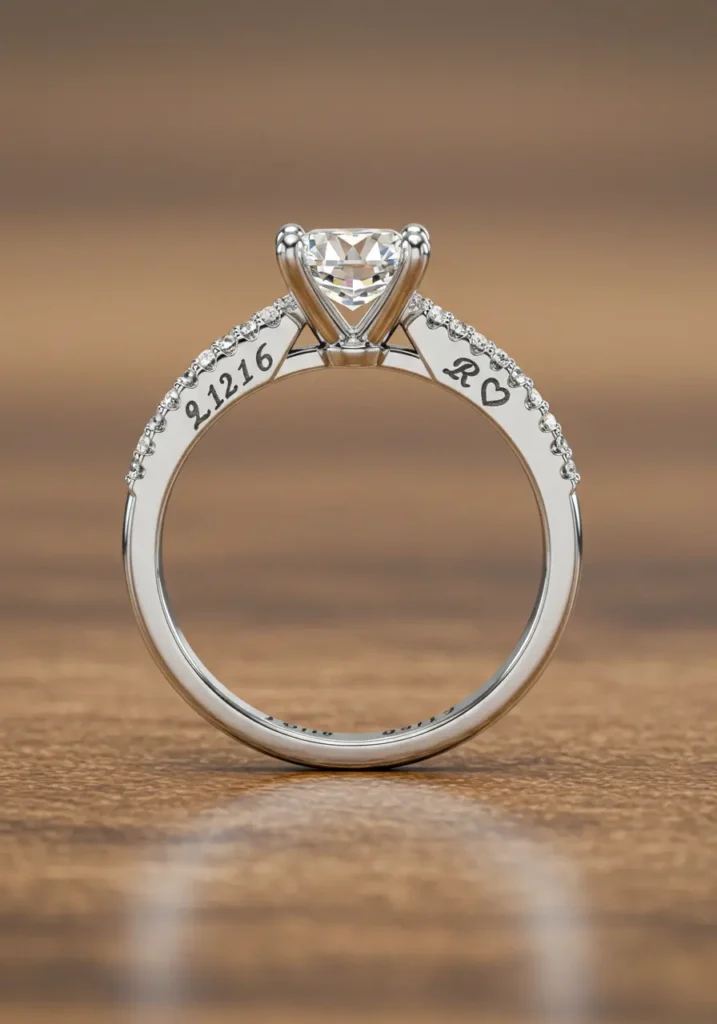
Customize the ring with meaningful engravings on the inside of the band, or even on the side of the setting itself. Hidden messages, dates, or initials add a secret, intimate touch visible only to the wearer.
18. Oval Cut Diamond with a Thin Pavé Band

A classic yet modern choice. An elongated oval cut diamond sits atop a delicate, thin band adorned with tiny pavé-set diamonds. This maximizes the diamond’s size and brilliance while maintaining a refined, elegant look.
19. Geometric Cluster Ring (Non-Traditional)
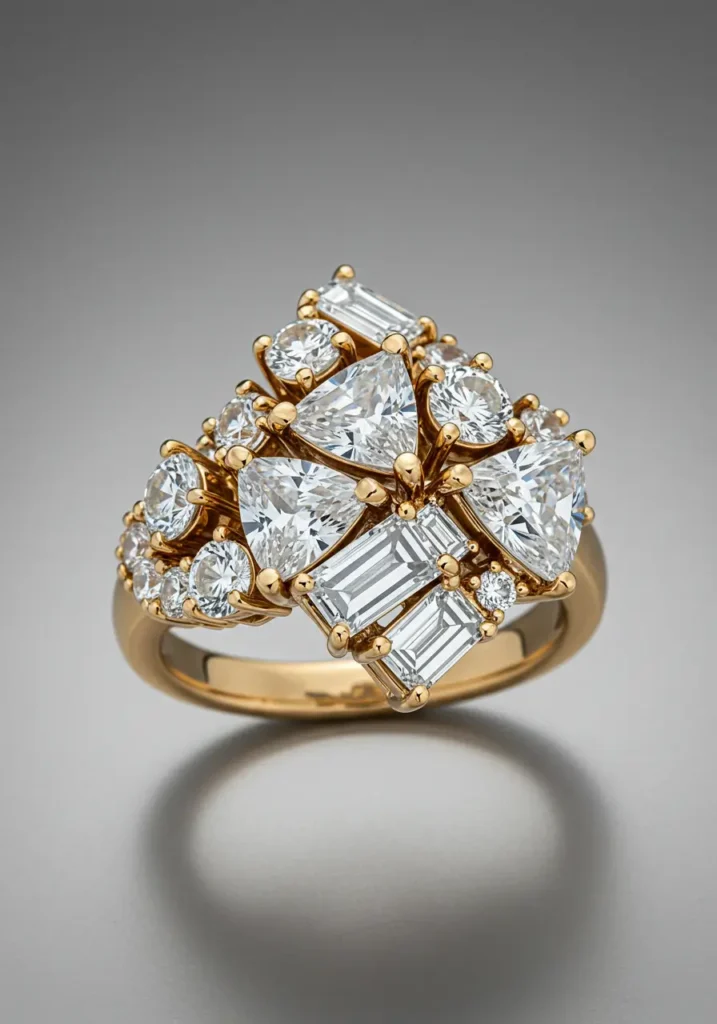
Instead of a single center stone, create a cluster of various shaped gemstones (e.g., triangle, baguette, round) arranged in a unique, asymmetrical, or geometric pattern. This offers a modern, artistic, and highly individualistic aesthetic.
20. Textured or Hammered Band

For a unique and organic feel, choose a band with a textured finish, such as a hammered metal or a brushed matte look. This adds subtle interest and a handcrafted feel, perfect for a non-traditional aesthetic in Custom Engagement Rings.
Budgeting for Custom Engagement Rings: A Smart Investment
Creating Custom Engagement Rings is a significant investment, but one that can be tailored to various budgets. Understanding cost factors helps you plan effectively.
Factors Influencing Cost: The 4 Cs and Design
The cost of Custom Engagement Rings depends on several key factors:
Gemstone: Diamond quality (Carat, Cut, Color, Clarity) or alternative gem choice. Lab-grown diamonds offer a more affordable option than natural.
Metal: Platinum is generally most expensive, followed by gold (18k more than 14k).
Design Complexity: Simple solitaires cost less for customization than intricate filigree or multi-stone settings.
Labor: The jeweler’s time and expertise for custom work (design, casting, setting).
Certification: For diamonds, ensure GIA or AGS certification.
Understanding these elements helps manage the budget for Custom Engagement Rings.
Budgeting Ranges for Custom Engagement Rings
While highly variable, here are general ranges for Custom Engagement Rings:
Entry-level Customization ($2,000-$5,000): Might involve customizing a semi-mount setting with your chosen center stone or adding simple engravings.
Mid-Range Custom ($5,000-$15,000): Allows for more intricate designs, higher quality center stones, or unique settings with more labor.
High-End Custom ($15,000+): Involves rare or large gemstones, complex bespoke designs, multiple high-quality accent stones, and premium metals.
Always discuss your budget openly with your jeweler.
Smart Savings for Your Custom Ring
Consider these tips to optimize your budget for Custom Engagement Rings:
Lab-Grown Diamonds: Offer significant savings compared to natural diamonds with identical chemical, physical, and optical properties.
Alternative Gemstones: Sapphires, moissanite, or morganite can be beautiful and more affordable.
Metal Choice: 14k gold is more durable and less expensive than 18k or platinum.
Simplify Setting: A simpler setting allows more budget for the center stone.
Shop Smart: Compare reputable jewelers, but prioritize trust and craftsmanship for Custom Engagement Rings.
Caring for Your Custom Engagement Ring: A Timeless Heirloom
Proper care ensures your Custom Engagement Ring maintains its brilliance and integrity for a lifetime, becoming a cherished heirloom. Consistent maintenance protects your significant investment.
Regular Cleaning: Maintaining Brilliance
Clean your Custom Engagement Ring regularly to maintain its sparkle. Use a soft brush (like a soft toothbrush) and a mild soap (e.g., dish soap) in warm water. Gently scrub the stone and setting to remove oils and dirt. Rinse thoroughly under running water and dry with a lint-free cloth. Avoid harsh chemicals or abrasive cleaners. Ultrasonic cleaners can be used for diamonds but use caution with certain gemstones.
Safe Wearing Habits: Protecting from Damage
Remove your Custom Engagement Ring before engaging in activities that could damage it. This includes:
Housework: Cleaning chemicals and abrasive tasks.
Gardening or heavy lifting: Impacts can bend settings or loosen stones.
Swimming: Chlorine can damage metals.
Working with lotions/creams: Can build up under stones, reducing sparkle.
Store your ring safely in a jewelry box or soft pouch when not wearing it. This prevents scratches and accidental damage.
Professional Inspections and Maintenance
Schedule professional inspections for your Custom Engagement Ring at least once a year (or every six months for very active wearers). A jeweler can check prongs for looseness, clean hard-to-reach areas, and address any minor issues before they become major problems. This professional care ensures the security of your gemstone and the longevity of your setting.
This regular check-up is crucial for a Custom Engagement Ring.
Latest Innovations in Engagement Ring Design and Sourcing
The jewelry industry continually innovates, bringing new technologies and ethical practices that enhance the possibilities and transparency of engagement ring design. These advancements influence Custom Engagement Rings.
Lab-Grown Diamonds: Ethical and Sustainable Choices
Lab-grown diamonds are a significant innovation. They are chemically, physically, and optically identical to mined diamonds but are created in a laboratory. They offer a more ethical and sustainable choice. They are also typically more affordable, allowing for larger or higher-quality stones within a given budget. This option provides a compelling alternative for Custom Engagement Rings.
This innovation offers transparency in sourcing and reduces environmental impact.
3D Printing and CAD Design: Precision Customization
Computer-Aided Design (CAD) software and 3D printing technology have revolutionized custom ring design. Jewelers can create precise 3D models of Custom Engagement Rings, allowing clients to visualize every detail before casting. 3D printing then creates highly accurate wax models for casting, ensuring intricate designs are flawlessly executed. This technology offers unparalleled precision and customization.
This allows for complex and unique designs previously impossible or extremely costly.
Blockchain for Diamond Tracing: Enhanced Transparency
Blockchain technology is increasingly used to trace the origin of diamonds. This provides an immutable record of a diamond’s journey from mine to market, ensuring ethical sourcing and preventing “conflict diamonds.” This transparency offers peace of mind for consumers concerned about ethical considerations. This innovation brings greater accountability to the diamond supply chain.
Making Your Final Decision: Crafting Your Perfect Custom Engagement Ring
Designing Custom Engagement Rings is a deeply personal and rewarding experience. Your final decision should reflect your unique love story and your partner’s individuality.
Prioritize open communication with your jeweler. Share your vision, budget, and any personal details you wish to incorporate. A reputable jeweler guides you through the process, offering expertise and creative solutions.
Consider the gemstone that best symbolizes your love. While diamonds are classic, alternative gemstones or lab-grown diamonds offer unique beauty and value.
Do not overlook the importance of metal choice and setting style. These elements provide the backdrop for your chosen gem and impact the ring’s overall durability and aesthetic.
Remember, the perfect Custom Engagement Rings are those that speak to your heart and beautifully represent your commitment. When chosen with care and intention, they become a cherished symbol of your unique love story for a lifetime.
Your Forever Symbol: Crafting Unique Custom Engagement Rings
Custom Engagement Rings offer an unparalleled opportunity to create a unique symbol of your love, reflecting your personal story and partner’s style. This bespoke approach ensures your proposal is truly one-of-a-kind.
Take time to explore gemstone options, metal choices, and setting styles. Collaborate closely with a trusted jeweler. Remember that every detail contributes to the ring’s personal significance.
As you embark on this creative journey, remain focused on crafting a piece that genuinely embodies your shared commitment. Your thoughtfulness will shine through.
By embracing the world of Custom Engagement Rings, you design more than just jewelry. You create a cherished heirloom, a tangible representation of your unique and enduring love story.
Frequently Asked Questions About Custom Engagement Rings
What are Custom Engagement Rings?
Custom Engagement Rings are rings designed from scratch or significantly modified to reflect a couple’s unique preferences, story, and style. This involves choosing specific gemstones, metals, settings, and adding personalized details not found in ready-made rings.
Are Custom Engagement Rings more expensive than ready-made ones?
Not necessarily. While highly intricate designs can be more expensive, Custom Engagement Rings can sometimes be more budget-friendly. This is because you control every element, allowing you to prioritize the most important features (e.g., a larger gemstone with a simpler setting) to fit your budget.
How long does it take to create Custom Engagement Rings?
The timeline for Custom Engagement Rings varies. It typically takes 4-8 weeks, depending on the complexity of the design, the availability of gemstones, and the jeweler’s schedule. It is advisable to start the process well in advance of your proposed date.
Can I use a lab-grown diamond for Custom Engagement Rings?
Yes, lab-grown diamonds are a popular and ethical choice for Custom Engagement Rings. They are chemically, physically, and optically identical to mined diamonds but are typically more affordable, allowing for a larger or higher-quality stone within the same budget.
What kind of personal details can I add to Custom Engagement Rings?
You can add various personal details, such as engravings (dates, initials, phrases), hidden birthstones on the inside of the band, unique filigree designs, specific side stones that hold meaning, or elements reflecting a shared hobby or significant place.
This Post Contains Affiliate Links

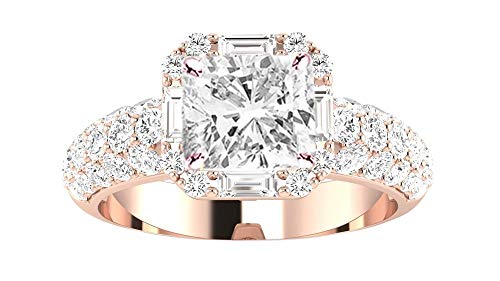
![Top 20 Custom Engagement Rings – Unique Designs for Your Perfect Proposal 1-5 Carat (ctw) White Gold Pear Cut LAB GROWN Diamond Halo Engagement Ring [ Color E-F, Clarity VS2-SI1 ]](https://m.media-amazon.com/images/I/413AGWU-HLL._SL500_.jpg)


